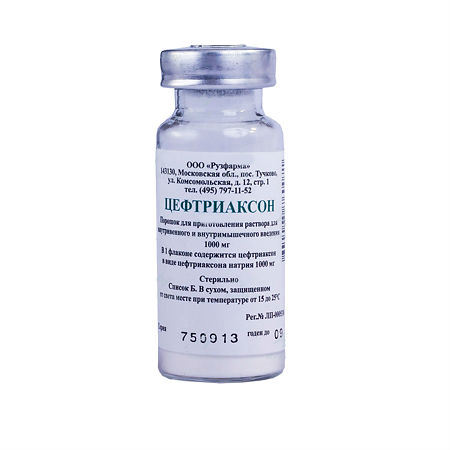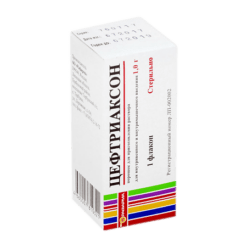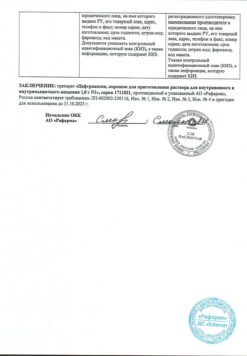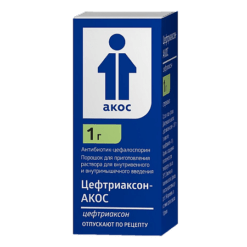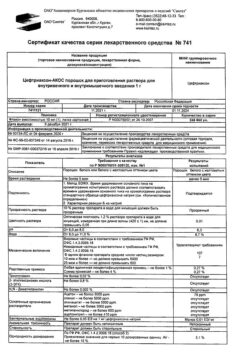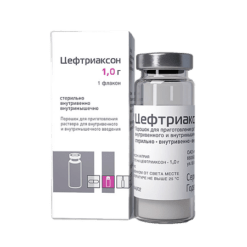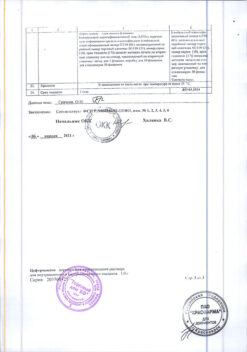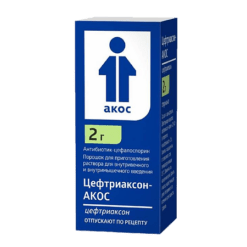No products in the cart.
Ceftriaxone, 1 g
€1.00
Out of stock
(E-mail when Stock is available)
Description
Salmonellosis, Biliary tract infections, Osteomyelitis, Otitis, Bronchitis, Infectious diseases, Lung inflammation (pneumonia), Respiratory tract infections, Cholecystitis, Guillotine, Skin infections, Intestinal infections, Urinary tract infections
Treatment of infections caused by susceptible microorganisms:
– sepsis;
– meningitis;
– disseminated Lyme borreliosis (early and late stages of the disease);
– infections of the abdominal organs (peritonitis, infections of the biliary tract and gastrointestinal tract);
– bone and joint infections;
– skin and soft tissue infections;
– wound infections;
– infections in immunocompromised patients;
– pelvic organ infections;
– kidney and urinary tract infections;
– respiratory tract infections (especially pneumonia);
– ENT organ infections;
– genital tract infections, including gonorrhea.
Prophylaxis of infections in the postoperative period.
Active ingredient
Active ingredient
Composition
Composition
Powder for preparation of solution for intravenous and intravenous injections is crystalline, almost white or yellowish in color.
1 bottle of ceftriaxone (in the form of sodium salt) 1 g
How to take, the dosage
How to take, the dosage
The drug is administered by m/m or intravenously.
Adults and children over 12 years of age are prescribed 1-2 g once daily (every 24 hours). In severe cases or in infections whose pathogens have only moderate sensitivity to ceftriaxone, the daily dose may be increased to 4 g.
Infants (up to 2 weeks) Appointed at 20-50 mg/kg of body weight once/day. The daily dose should not exceed 50 mg/kg of body weight. In determining the dose, no distinction should be made between preterm and premature infants.
Infants and young children (from 15 days to 12 years) are given 20-80 mg/kg of body weight once daily.
Children with a body weight of >50 kg are prescribed doses intended for adults.
Doses of 50 mg/kg or more for IV administration should be administered by drip for at least 30 minutes.
Patients of advanced age should be given the usual doses intended for adults, without adjustment for age.
The duration of treatment depends on the course of the disease. Ceftriaxone should be continued in patients for at least 48-72 hours after normalization of the temperature and confirmation of eradication of the pathogen.
In bacterial meningitis in infants and young children treatment begins with a dose of 100 mg/kg (but no more than 4 g) once daily. After identification of the pathogen and determination of its sensitivity, the dose can be reduced accordingly.
In meningococcal meningitis the best results were achieved with a treatment duration of 4 days, with meningitis caused by Haemophilus influenzae, – 6 days, Streptococcus pneumoniae, – 7 days.
In Lyme borreliosis: adults and children over 12 years are administered 50 mg/kg once daily for 14 days; maximum daily dose is 2 g.
In Gonorrhea (caused by penicillinase-forming and non-forming strains) – once in/m at a dose of 250 mg.
In order to prevent postoperative infections depending on the degree of infection risk, the drug is administered in a dose of 1-2 g once 30-90 minutes before surgery.
Insurgeries on the colon and rectum, simultaneous (but separate) administration of Ceftriaxone and one of the 5-nitroimidazoles, such as ornidazole, is effective.
In patients with disordered renal function there is no need to reduce the dose if liver function remains normal. In cases of preterminalsevere renal failure with CK< 10 ml/min, the daily dose of the drug should not exceed 2 g.
In patients with impaired liver function there is no need to reduce the dose if renal function remains normal.
In combination of severe renal and hepatic impairment, plasma ceftriaxone concentrations should be determined regularly and the dose should be adjusted if necessary.
Patients undergoing dialysis dialysis do not require additional administration of the drug after dialysis. However, the serum ceftriaxone concentration should be monitored for timely dose adjustment since the drug excretion rate may be decreased in these patients.
Rules for preparation and administration of solutions
Actually administered
The contents of the bottle (1 g) are dissolved in 3.6 ml of water for injection. After preparation, 1 ml of the solution contains about 250 mg of ceftriaxone. If necessary, a more diluted solution can be used.
As with other IV/m injections, ceftriaxone is injected into a relatively large muscle (gluteus maximus); trial aspiration helps avoid inadvertent injection into a blood vessel. It is recommended that no more than 1 g of the drug be injected into a single muscle. To reduce pain during I/M injections the drug should be injected with 1% lidocaine solution. Lidocaine solution should not be injected intravenously.
For intravenous administration
The contents of the vial (1 g) are dissolved in 9.6 ml of water for injection. After preparation, 1 ml of the solution contains about 100 mg of ceftriaxone. The solution is administered slowly over 2-4 minutes.
For intravenous infusion
Dissolve 2 g Ceftriaxone in 40 ml of sterile water for injection or one of the calcium-free infusion solutions (0.9% sodium chloride solution, 2.5%, 5% or 10% dextrose solution, 5% levulose solution, 6% dextran in dextrose solution). The solution is administered within 30 minutes.
Interaction
Interaction
Ceftriaxone, by inhibiting intestinal flora, interferes with vitamin K synthesis.
Concomitant administration with drugs that reduce platelet aggregation (NSAIDs, salicylates, sulfinpyrazone) increases the risk of bleeding. In concomitant administration with anticoagulants the effect of the latter is increased.
Concomitant use with “loop” diuretics increases the risk of nephrotoxic action.
The ceftriaxone and aminoglycosides are synergistic against many Gram-negative bacteria.
Incompatible with ethanol.
Pharmaceutical interactions
Ceftriaxone solutions should not be mixed or administered simultaneously with other antimicrobial agents. Ceftriaxone should not be mixed with solutions containing calcium.
Special Instructions
Special Instructions
In simultaneous severe renal and hepatic insufficiency, in patients on hemodialysis, plasma concentrations of the drug should be determined regularly.
Peripheral blood count, liver and renal function parameters should be monitored regularly during long-term treatment.
In rare cases of ultrasound investigation of the gallbladder there are blackouts which disappear after discontinuation of therapy (even if this phenomenon is accompanied by right-subcostal pain, continuation of antibiotic therapy and symptomatic treatment is recommended).
Do not drink alcohol during treatment, since disulfiram-like effects are possible (redness of the face, cramps in the stomach and stomach area, nausea, vomiting, headache, decreased BP, tachycardia, shortness of breath).
Despite a detailed history, which is the rule for other cephalosporin antibiotics, we cannot rule out the possibility of anaphylactic shock, which requires immediate therapy – first IV infusion of epinephrine, then GCS.
In vitro studies have shown that, like other cephalosporin antibiotics, ceftriaxone is able to displace bilirubin bound to serum albumin. Therefore, in neonates with hyperbilirubinemia and especially in premature infants, the use of Ceftriaxone requires even greater caution.
Elderly and debilitated patients may require administration of vitamin K.
The prepared solution should be stored at room temperature for no more than 6 hours or in the refrigerator at 2-8° C for no more than 24 hours.
Side effects
Side effects
Allergic reactions: hives, chills or fever, rash, itching; rarely – bronchospasm, eosinophilia, exudative erythema multiforme (including Stevens-Johnson syndrome), serum sickness, anaphylactic shock.
Digestive system disorders: Nausea, vomiting, diarrhea or constipation, flatulence, abdominal pain, taste disorders, stomatitis, glossitis, pseudomembranous enterocolitis, liver function disorders (increased activity of liver transaminases, less often – alkaline phosphate or bilirubin, cholestatic jaundice), gallbladder pseudocholithiasis (“sludge” syndrome), dysbacteriosis.
With regard to the hematopoietic system: anemia, leukopenia, leukocytosis, neutropenia, granulocytopenia, lymphopenia, thrombocytosis, thrombocytopenia, hemolytic anemia, hypocoagulation, reduced concentration of plasma clotting factors (II, VII, IX, X), prolongation of prothrombin time.
With the urinary system: disorders of renal function (azotemia, increased blood urea, hypercreatininemia, glucosuria, cylinduria, hematuria), oliguria, anuria.
Local reactions: phlebitis, soreness along the course of the vein, soreness and infiltration at the site of injection/injection.
Others: headache, dizziness, nosebleeds, candidiasis, superinfection.
Overdose
Overdose
In case of overdose hemodialysis and peritoneal dialysis do not reduce the drug concentration. There is no specific antidote.
The treatment of overdose is symptomatic.
Additional information
| Manufacturer | Ruzpharma, Russia |
|---|---|
| Medication form | Powder for preparation of solution |
| Brand | Ruzpharma |
Other forms…
Related products
Buy Ceftriaxone, 1 g with delivery to USA, UK, Europe and over 120 other countries.

